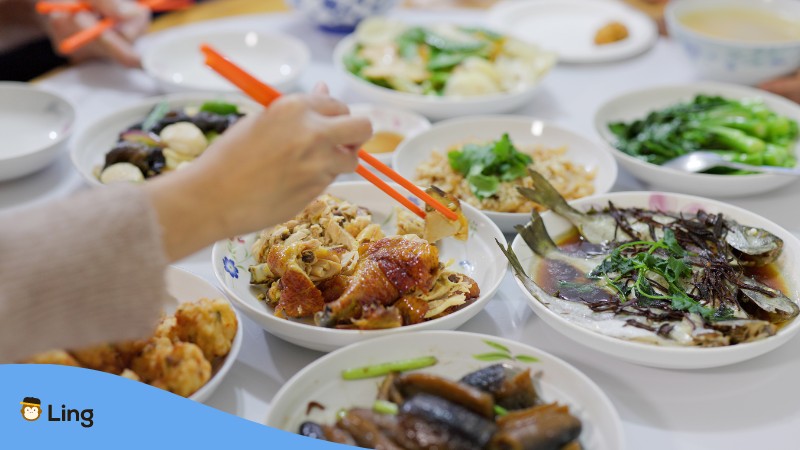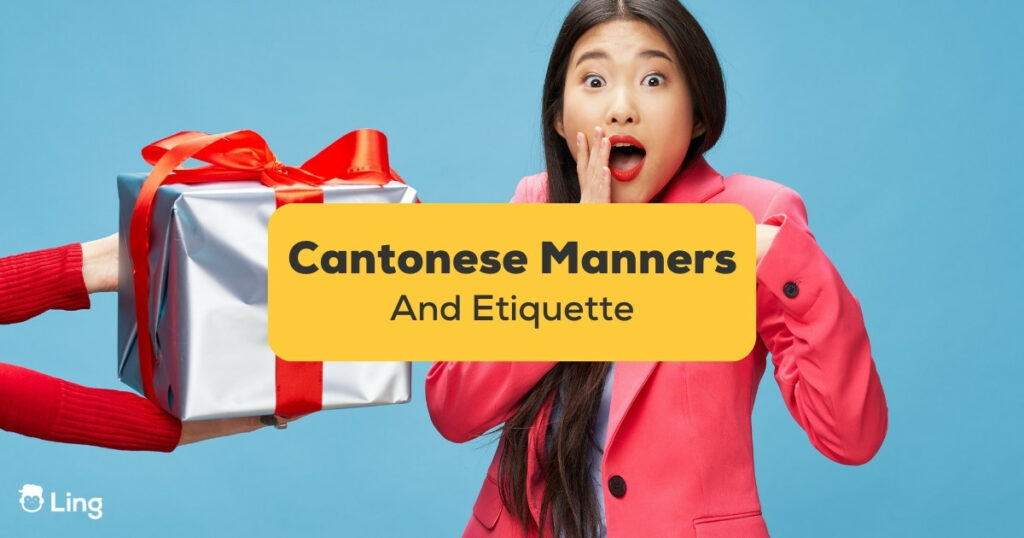Cantonese culture is rich with customs and traditions, many of which revolve around good manners and etiquette. From how they greet each other to how they eat their meals, these customs play a significant role in Cantonese’s daily interactions.
So get ready to have a blast as we learn the exciting world of Cantonese manners and etiquette in today’s post! Whether you’re a Hong Kong businessperson or just a tourist, this is the perfect opportunity to gain a deeper understanding and appreciation of Cantonese culture. Let’s start!
Greetings And Introductions In Cantonese
Traditional Cantonese Greetings
Greetings in Cantonese culture are about showing respect and putting your best foot forward. In Cantonese, one traditional greeting is “Néih hóu” (你好), which roughly translates to “hello.” But that’s just the tip of the iceberg! You can use many other greetings, depending on the time of day, your relationship with the person, and other factors.
If you’re a language learner, mastering basic greetings and conversational phrases in Cantonese is a great place to start. Here are a few to get you started:
| English | Cantonese | Pronunciation |
| Hello | 你好 | néih hóu |
| Goodbye | 再見 | zài jiàn |
| How are you? | 你好嗎? | néih hóu ma? |
| Excuse me | 唔該 | m4 koi |
| Good morning | 早晨 | jóu sàn |
| Good evening | 晚安 | wàan ōn |
How To Address Elders And Those Of Higher Social Status
In traditional Hong Kong Chinese society, showing respect to elders and those of higher social status is crucial. To express this respect, use proper titles when addressing them, such as calling grandfather “ye ye” (爺爺 ) or grandmother “nǎi nai” (奶奶). Also, remember always to use formal language and steer clear of slang or colloquial expressions when speaking to someone older or of higher status as a sign of respect and deference.
The Significance Of Gift-Giving In Introductions
Gift-giving plays a significant role in introductions to Hong Kong society and Cantonese people. It’s a way to show respect and build relationships, whether meeting someone for the first time, visiting their home, or celebrating a special occasion. There’s no need to worry about finding the perfect gift or “wun mei dik lai mat” (完美的禮物). Just bring something thoughtful and sincere, and you’re good to go!

Table Manners In Cantonese Culture
The Use Of Chopsticks
Chopsticks or “kuài zi” (筷子) hold a special place in Cantonese food culture, and using them properly is a must-know in Cantonese dining etiquette. When handling chopsticks, showing respect by not pointing or gesturing with them is essential. Place them parallel on the table or chopstick rest when not in use. And here’s a fun fact, never stick your chopsticks upright in your rice bowl, as it’s considered bad luck in Cantonese culture!
How To Handle Bowls And Plates In Cantonese Dining Etiquette
Like in other Asian countries, sharing is caring in Cantonese dining, which extends to bowls (wun, 碗)and plates (pun zi, 盤子) too! When it’s time to dig in, hold the bowl close to your mouth and feel free to slurp (don’t make it loud)– it’s a sign of enjoyment in Cantonese culture. Use chopsticks to transfer food from communal plates to your bowl to be a proper gentleman or lady at the dinner table. If you’re done eating, it’s a polite gesture to leave a small portion of food on your plate. An empty plate might signal to your host that you did not receive enough food and would like a refill.
The Traditional Etiquette Of Pouring And Serving Tea
Tea or “chá” (茶) is a big deal in Chinese culture, and the way it’s served and poured is full of rich traditions. If you’re serving tea to someone older or with a higher social status, it’s a sign of respect to pour it with both hands and present it to them politely. And when you receive a cup of tea, it’s a polite gesture to take it with both hands and take a sip before setting it down.
Vocabulary Related To Dining
It’s always helpful to learn Cantonese or any new language to expand your vocabulary in relevant areas. And if you’re interested in Cantonese manners and etiquette, you should learn some common phrases related to dining and chopsticks.
| English | Cantonese | Pronunciation |
| Food | 食物 | sihk maht |
| Rice | 米飯 | mai faan |
| Noodles | 麵條 | min tiu |
| Soup | 湯 | tong |
| Dish | 盤 | pán |
| Plate | 碟 | dei |
| Spoon | 湯匙 | tong si |
| Knife | 刀 | dou |
| Fork | 叉 | caa |

Public Behaviour In Cantonese Culture
Respect For Personal Space
Regarding public behavior in Cantonese-speaking areas, respecting others’ personal space is important. This means keeping a reasonable distance from others while standing in line, riding the subway, or walking around. However, it’s also important to remember that personal space might be limited in crowded places like marketplaces or busy streets. In these situations, be patient and understanding; everything will work out just fine!
Avoiding Loud Or Disruptive Behavior In Public
Being mindful of your volume and behavior in public is a crucial part of Cantonese manners and etiquette. It shows respect and consideration for others. It’s also essential in crowded places like markets (si chaang, 市場), streets (gaai dou, 街道), or public transportation (gung gung gaau tung, 公共交通). So, keep the volume down, be mindful of your surroundings, and enjoy the cultural experience with a low profile.
The Importance Of Queueing And Waiting For One’s Turn
For Chinese people, there’s a strong emphasis on being respectful and polite when you’re out in public. This includes making sure you take turns and wait your turn when you’re in line or waiting for something. So if you’re at a bus stop or “baa si jan” (巴士站), standing in a queue for a popular attraction, or simply waiting for someone to finish talking. Then you must show patience and avoid cutting in line. This shows respect for others and helps keep the public environment calm and orderly. Observing these customs demonstrates that you’re a considerate and well-mannered individual who values the people and traditions around you.
Expressions For Polite Requests And Apologies
If you’re trying to improve your Cantonese, incorporating polite phrases for making requests and apologizing can be a helpful and effective way to build your language skills.
| English | Cantonese | Pronunciation |
| Please | 請 | ching |
| Excuse me | 對不起 | deoi bat hei |
| May I have…? | 可以給我…嗎? | ho yi kap ngo … ma? |
| Can you help me? | 你可以幫助我嗎? | nei ho yi bong zu ngo ma? |
| Thank you very much | 非常謝謝 | fei seung je ze |
| Would you like…? | 你想要…嗎? | nei seung yiu … ma? |
Gift-Giving Etiquette In Cantonese Culture
Appropriate Gifts For Different Occasions
The Cantonese people value gifts from their hearts. Show your appreciation by bringing tea or sweets to weddings, flowers, or a small plant when visiting someone’s home. You can also give a useful item like a desk accessory or calendar to celebrate a new job or promotion. As a rule of thumb, avoid odd numbers (considered unlucky), intimate clothing, or anything too over-the-top. Stick to thoughtful, meaningful, and fitting gifts for the occasion, and impress your Cantonese friends!
The Significance Of Wrapping And Presentation
Wrapping gifts in Cantonese culture is just as meaningful as the gift itself. Choose a pretty wrapping paper and ribbon and arrange the present carefully to show your thoughtfulness. Avoid using white or black paper when wrapping, as they are associated with mourning and death. Instead, choose gold or red (lucky colors) or neutral colors for a more appropriate look. When giving gifts, ensure your presentation shows your care and consideration for the recipient.
The Chinese Etiquette Of Giving And Receiving Gifts
In Cantonese culture, you should also show respect when giving or receiving a gift or “lai mat” (禮物). Hold the gift with both hands and refuse it at least 2-3 times before accepting. And don’t get too excited opening them! It’s best to open presents after leaving the person’s presence unless they ask you to open them immediately.
Avoid giving sharp objects, like knives or scissors, or items associated with separation, death, or bad luck, like clocks, handkerchiefs, and umbrellas. Instead, go for gifts from your home country or fresh fruits in a nice box or basket. Just avoid giving pears, as they symbolize separation.
Expressions For Thanking And Complimenting Gifts
Now it’s time to brush up on your Cantonese by memorizing phrases to express gratitude and compliments. Your gift giver might be so impressed that they’ll start showering you with presents!
| English | Cantonese | Pronunciation |
| That’s so kind of you | 你真好 | nei jan hou |
| How thoughtful of you | 你真體貼 | nei jan tai tip |
| I really appreciate it | 我非常感激 | ngo fei seung gam gat |
| You’re too kind | 你太好了 | nei tai hou liu |
| This is just what I needed | 這正是我需要的 | ze san si ngo sui yiu dik |

Learn The Cantonese Language With Ling
Mastering Cantonese manners and etiquette must be on your list to make a positive impression and build strong relationships in Hong Kong and Cantonese-speaking areas. Learning this unique culture can be fun and rewarding with the right resources.
However, one of the best ways to truly appreciate this Asian culture is by learning its language. And if you’re ready for that? Then Ling can help!
Ling is a revolutionary language-learning platform built for language enthusiasts like you! Join the millions of users worldwide who have already enhanced their Cantonese skills and sign up for a free account today.
Try it out by downloading it from Google Play and App Store now!



































































